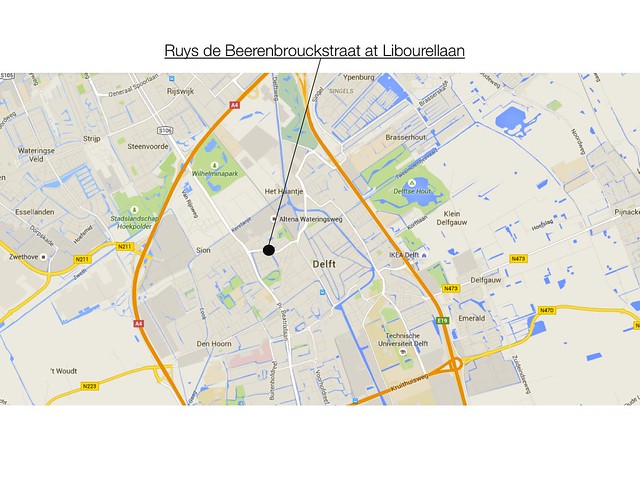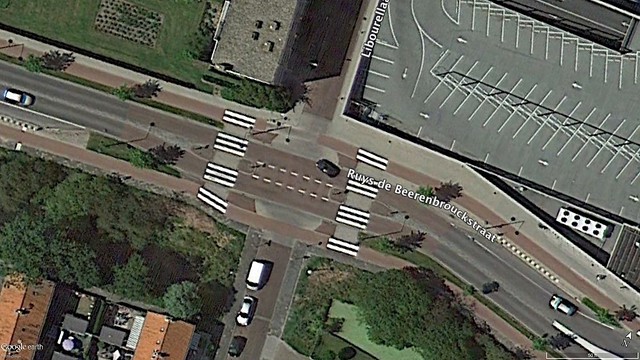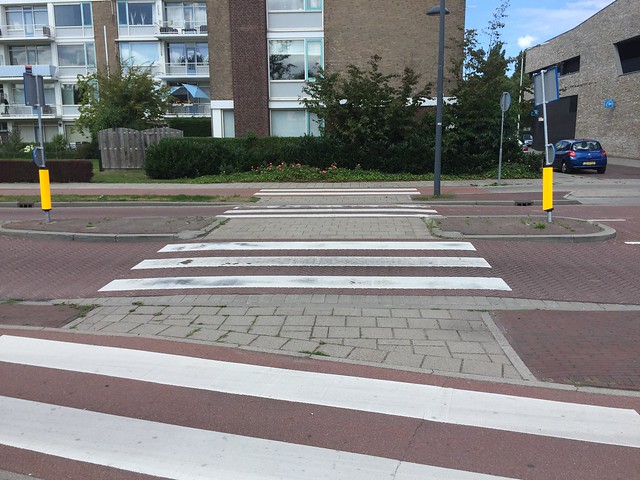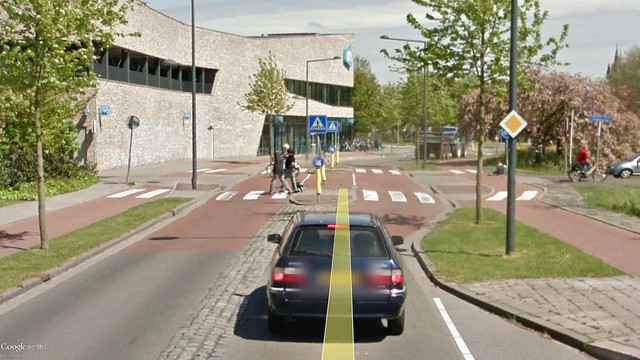Crossing Island Across 1+1 Lane Road
Sustainable Safety Elements
[by Ryan Cullen]Sustainable Safety refers to the current national Dutch initiative to improve traffic safety throughout the country. Differing from past approaches which acted reactively to improve dangerous locations after accidents occurred, the sustainable safety approach is aimed at making design improvements systemically – before accidents occur.
In the pursuit of preventing as many accidents as possible, and reducing the damage in accidents that do occur, sustainable safety was founded on the following user principle:
- Base designs on human characteristics and tendencies
- People make mistakes
- People make violations of design intention consciously and unconsciously
- People are physically vulnerable
Ruys de Beerenbroukstraat at the intersection with Libourellaan in the city of Delft exhibits an example of crossing design configuration which furthers the goals stated above. Ruys de Beerenbroukstraat is a 50 km/h urban distributor road uniquely designed to promote speeds of 45 km/h or less. For more information on the functionality of this street, refer to [Urban Distributor Road].
Design Overview
This intersection was signalized until 2008 when the reconstruction of the road included removing the traffic control system in favor of the configuration shown above. On approach to the intersection, travel lanes deflect horizontally to create an 8′ crossing island. At the crosswalk, the travel lanes deflect vertically to curb level to create a crossing table with ladder striping. Crosswalks are provided on both the east and west sides of the intersection to reduce pedestrian delay for all desire lines. Also notice the change in roadway material from asphalt to red pavers at the intersection; drivers should recognize that red pavers are typically used to denote a street of lower status and high priority to cyclists and pedestrians.
Physical design elements:
- Horizontal deflection of travel lane
- Vertical deflection of travel lane to crossing table
- 8′ pedestrian island
- Change in material of intersection
Pictured above: The 8′ wide crossing island requires pedestrians to cross only one lane at a time.
Looking across the crosswalk, notice the slight vertical deflection of the roadway pavers in comparison to the curb of the crossing island. This rise in the roadway acts as a speed hump for passing vehicles and further communicates the space as prioritizing people crossing. Creating this crossing table also makes crossing easier for those using wheelchairs or scooters, as the roadway is flush with the pedestrian island and crosswalk.
Picture above: Pedestrians complete their crossing from the crossing island. Notice the car approaching the crossing has applied its brakes despite the fact that the pedestrians have already exited its lane. This suggests the geometries of the intersection induce slow speeds and heightened attention regardless of whether someone is using the crosswalk.
Application of Sustainable Safety
The application of sustainable safety here is ultimately based on human characteristics and tendencies; people make mistakes, people make conscious and unconscious violations of design intent, and, most importantly, people are physically vulnerable. Designing first with people in mind, crossing is made as simple as possible by requiring only a single lane to be crossed at a time. Additionally, striping, deflection, materiality changes, and signage are used to make pedestrians’ right of way as clear as possible for all users. In regard to the vulnerability of people, the roadway deflections act to slow vehicles – ideally to speeds lower than would critically injure a pedestrian. This is important in light of the last concept of sustainable safety, the idea that people make mistakes and violations, and that physically vulnerable people require protection. Under these circumstances, even in the event that mistakes are made by a driver, the speed of the car would likely be low enough to not critically injure a pedestrian in the crosswalk.
It is unlikely that this particular intersection would have been identified under the previous safety initiate as an accident-prone site requiring improvements. Fortunately, the sustainable safety program aims to incorporate an ideal design from the start and at any location where there is risk for accidents. These sustainable safety concepts work in harmony to both promote the desired user behaviors and simultaneously offer protection to the vulnerable users if accidents do occur.




